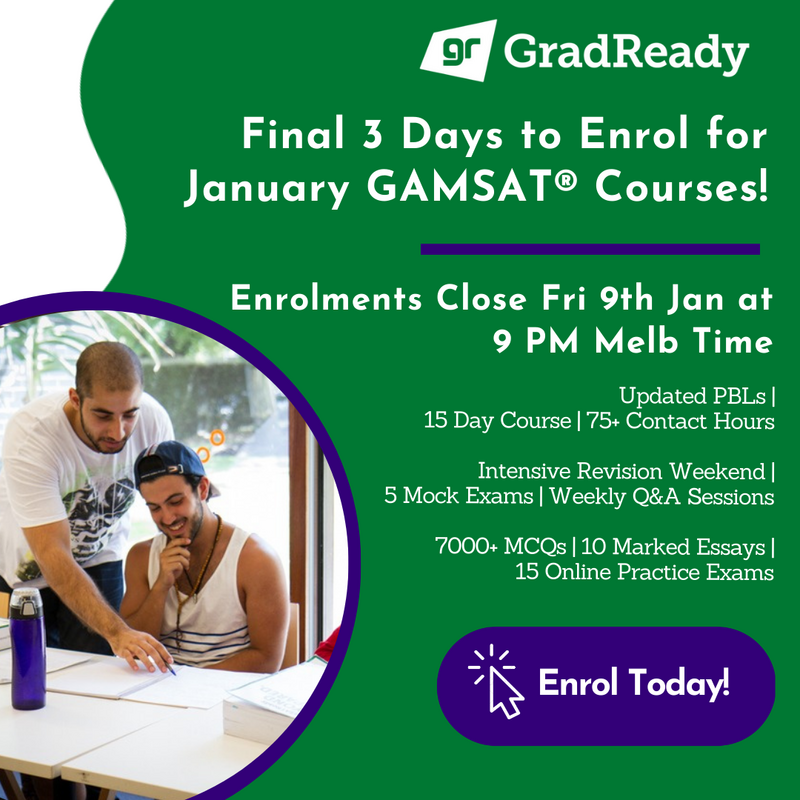Section 2 is a unique part of the GAMSAT
®, not just because it is the only section that is not in the standard MCQ format, but it really can make-or-break your medical school candidature. Although it may have a different weighing in terms of marks applied to it, it is not an under-estimation to state that the majority of students perform poorly in Section 2, which tends to affect their entire application. As most candidates are from a natural sciences background, most either under-estimate this section, or are overly scared and unsure as to how to approach it. This blog is designed to help you with this latter problem! Here I will discuss how to approach the stimuli you will receive in
GAMSAT Section 2 to help you ace the exam.
The orthodox way of teaching the GAMSAT
® is that you have to write an argumentative essay for the first stimuli (stimuli is a set of quotes, as below), and then write a personal reflective essay for the second stimuli. This is incorrect. There is no guidance from ACER on this point, and it is entirely up to us what style we write! In my own teaching, I still recommend that the argumentative essay style is useful, and especially when we encounter themes that broadly address politics and questions of society, but I heavily, heavily encourage my students to engage in some kind of creative writing alongside it—whether a fictional short story, a journal entry, a poem, a play, etc. Creative writing is the best way in which you can demonstrate your understanding and comprehension of human emotion, which, I believe, is the fundamental point of the written tasks in the GAMSAT
®.
Further, I recommend this because I believe the whole purpose of GAMSAT
® Section 2 is to demonstrate:
(1) That you can formulate an argument and come to a reasonable conclusion and be confident of your choice (very important skill as a doctor)
(2) Empathy through describing emotions between characters and social relations in a story (a vital skill as a doctor!).
What follows is an example approach of mine when looking at stimuli provided in Section 2, where I will look at the quotes,
break down the essay question, tease out the themes that are presented, and then structure my essay response.
Quotes:
“Most folks are as happy as they make up their minds to be.” Abraham Lincoln
“Happiness is not a goal; it is a by-product.” Eleanor Roosevelt
“The two enemies of human happiness are pain and boredom.” Arthur Schopenhauer
“The walls we build around us to keep sadness out also keep out the joy.” Jim Rohn
“History calls those men the greatest who have ennobled themselves by working for the common good; experience acclaims as happiest the man who has made the greatest number of people happy.” Karl Marx
Initially, you need to identify the theme. This is not a restrictive exercise. You should view this as an exercise in expanding the possibilities of what you can write about here! I always make a mind-map of themes that could appear from the quotes – I will go through each quote and identify the various themes from each. To identify the quotes, I usually try to think about the keywords here that will help me as well as the underlying messages the author is trying to communicate. Here are some themes I have identified in order:
- Happiness, mind set
- Happiness as the means, not the end
- Happiness, pain and boredom
- Emotional fragility
- Collective happiness, hope
Have a go at this yourself! Now that I have identified the theme(s), I can tell that this essay would lend itself better to creative writing (as it addresses aspects of human emotion/experience). And so, the next part of my plan is to think of a broad ‘plot’ in which my short essay will fit in. For example, I might think about the plot being ‘The life of a woman revolutionary in Tsarist Russia who conducts political activity and education to increase the revolutionary consciousness of citizens, and then during the Russian Revolution sacrifices herself to save others’. This is obviously a very long story, which could easily fit into a novel! The next step is to then think about a ‘sub-plot’ within this broader plot that you will actually write on, which focuses on a single event in this broader plot. For example, I might focus on her death and sacrifice to save perhaps a young girl from the machine-gun fire of Tsarist troops. This focus, I hope, will help me illustrate this character’s striving for collective happiness in the face of horror. As my students will know, the next important step is to consider the location of this sub-plot, the subject (i.e. main character), as well as the ‘object’ (i.e. what is the subject’s main interest/motivation?). Then, you will have all the elements to write an engaging, creative story!
Want more quotes to help you practice your essay writing skills? Take advantage of GradReady’s
free GAMSAT Section 2 Essay Quote Generator!






